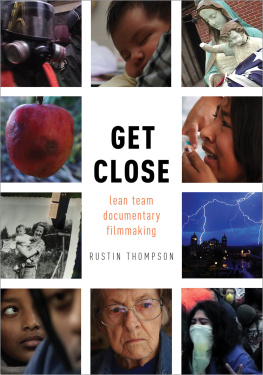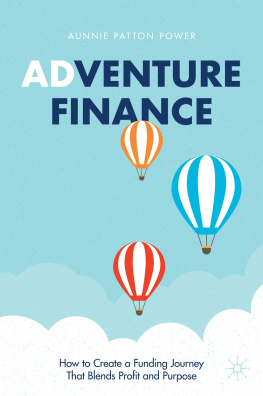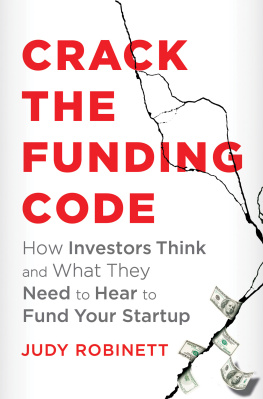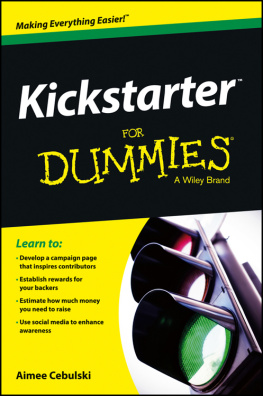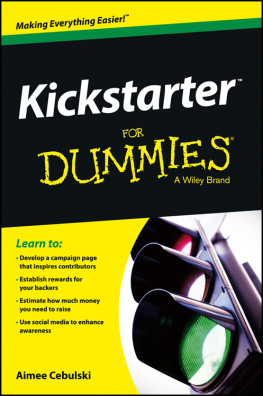Packed full of information, juxtaposed with kind words and wisdom from a woman who has spent her life nurturing filmmakers.
Barbara Trent, Academy Award winner for The Panama Deception
This book is the most intelligent, insightful and comprehensive guide to finding the money that I have ever read. Carole Dean is the independent filmmakers best friend!
Christopher Ward, award-winning independent filmmaker
Carole Dean has years of experience both as a producer and a funder, and her new book is full of nuts-and-bolts information from both sides of the fence, told in a conversational and heart-felt manner. Of special interest to filmmakers will be the in-depth interviews with experts in the field, and an extensive appendix chock full of references. A great new addition to the filmmakers lexicon.
Morrie Warshawski, consultant and author of Shaking the Money Tree
Carole is your mentor throughout the book. She leads wary filmmakers through the dark, daunting forest of nos to the green-light power of yes. The sensitive artist as successful producer is a rare commodity. Thats about to change. There are myriad, alternative ways to finance a film without selling your soul, and Carole Lee Dean knows them all.
Judi Jordan, editor-at-large, Latin StyleMagazine
In The Art of Film Funding, Carole Dean has assembled insights and wisdom that will prove immensely useful to filmmakers in their search for funding.
Mark Litwak, attorney and author
Carole Dean is well known in the motion picture industry for her innovations and creative genius. In her book, The Art of Film Funding, she has created a superb bible that will serve the novice as well as the seasoned filmmaker. Carole has utilized her experience in the industry and her talent to create a masterpiece a concise roadmap for financing a film which reads like a novel. This book is a major contribution and is bound to be the catalyst for valuable film production that the public and scholars would otherwise miss.
S. G. Fassoulis, film producer
This book is a good start toward seeing the world of funding through the eyes of experienced funders like Carole Dean and her colleagues. We need to master the techniques outlined here so we can create not just one or two films, but an ongoing body of work which will bring years of provocative insights to the public.
Patric Hedlund, author and filmmaker
My hats off to Carole Dean for writing The Art of Film Funding. Written with a spiritual perspective and trust for your intuition, she not only acknowledges these creative forces, but rightfully honors the business process as an art in itself! What a joyful journey into filmmaking.
Wendy De Rycke, indie producer
Carole Deans book successfully bridges the gap between the vision of the project and the realities of the market for the serious filmmaker.
Louise Levison, author of Filmmakers and Financing: Business Plans for Independents
Theres a saying in Spanish: There are two ways of spreading light; to be the candle; or the mirror that reflects it. Carole, you are both!
Efrem Logreira, producer
Carole Lee Dean knows the secrets of how to catch the attention of the people who can write the checks that enable you to make (or finish) your film. Her book offers an excellent overview of what you need to know to get started raising the funding for your dream project.
Catherine Clinch, Associate Publisher, Creative Screenwriting Magazine
THE ART OF
FILM FUNDING
ALTERNATIVE FINANCING CONCEPTS
CAROLE LEE DEAN
Published by Michael Wiese Productions
3940 Laurel Canyon Blvd.& 1111
Studio City, CA 91604
tel. 818.379.8799
fax 818.986.3408
mw@mwp.com
www.mwp.com
Cover Illustration: Kevin Capizzi
Book Layout: Gina Mansfield Design
Editor: Paul Norlen
Printed by McNaughton & Gunn, Inc., Saline, Michigan
Manufactured in the United States of America
2007 Carole Lee Dean
All rights reserved. No part of this book may be reproduced in any form or by any means without permission in writing from the publisher, except for the inclusion of brief quotations in a review.
Library of Congress Cataloging-in-Publication Data
Dean, Carole Lee.
The art of film funding : alternative financing concepts / Carole Lee Dean.
p. cm.
Includes bibliographical references and index.
ISBN 10: 1932907319
ISBN 13: 9781932907315
1. Motion picture industry--United States--Finance. I. Title.
PN1993.5.U6D35 2007
384.830973--dc22
2007013945
This book is dedicated to my exceptional children,
Rick Dean & Carole Joyce
TABLE OF CONTENTS
FOREWORD
Independent films and filmmakers are the new paradigm, a bona fide revolution. As studios over the last two decades have begun to act more and more like independents rather than the other way around, film funding has evolved also. Over the last seven years, the extraordinary success of such low-budget indie films as The Blair Witch Project, My Big Fat Greek Wedding and Napoleon Dynamite has brought an increasing number of average citizens into film funding. In addition, a score of billionaires have entered the fray, sponsoring features both fictional and non-fictional. As documentary films have entered the mainstream, so has the art of funding them.
Prior to the start of the 21st century, there werent enough theatrical docs that had earned significant revenues to make the discussion interesting. During the 1980s and 90s, there was a smattering of documentary box office triumphs. The success of Roger and Me in 1989 began the reemergence of the nonfiction film as a credible theatrical release. After a few successful films in the intervening years, 1994s Hoop Dreams attracted a lot of attention by accumulating North American box office receipts of $7.8 million on a budget of $800,000. The same year, Crumb reached a total of $3 million on a budget of $300,000. In 1997, a Best Documentary Oscar nominee, Buena Vista Social Club, scored almost $7 million at the box office and spun off a best-selling soundtrack album.
Nielsen Media Research has estimated that 85% of U.S. television households watch documentaries. Apparently much of this audience was no longer willing to wait for television rollouts and began going in larger numbers to see them in movie theaters first. At the same time, documentaries, influenced by Ken Burns and others bringing more creativity to the format, made films that would draw a movie theater audience. In addition, analysts feel that reality television has given viewers a taste for true-life stories, and thus helped the growth of the theatrical audience. As attendance figures for those crucial first weekends grew, distributors had the marketing ammunition to increase the attendance for succeeding screenings. The resulting box office revenues helped drive the value of docs to the video/DVD buyers and television programmers.
Critics and analysts proclaimed 2004 the year of the documentary. At first many thought that the success of the films was tied to the turbulent elections of 2000 and 2004 that perhaps Michael Moore was an anomaly as a documentarian and had managed to find a quirky loophole for making theatrical hits with Bowling for Columbine and Fahrenheit 9/11, and that succeeding political docs had snuck in through the same opening. However, when non-political films, such as Spellbound, Mad Hot Ballroom and the no-budget Super Size Me, also became successful, it became clear that docs of varying genres could compete with fiction features. Then in 2005 came
Next page



